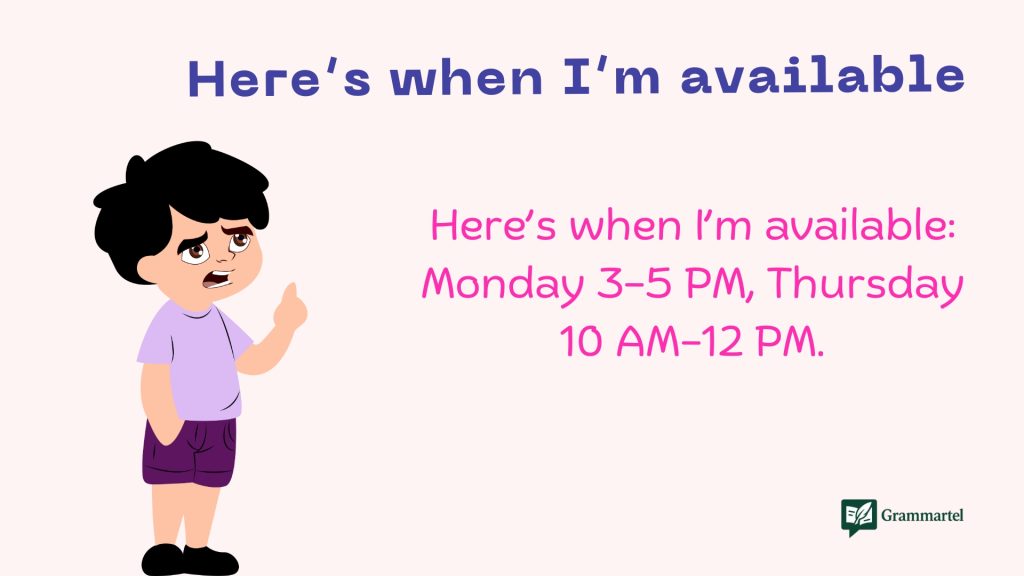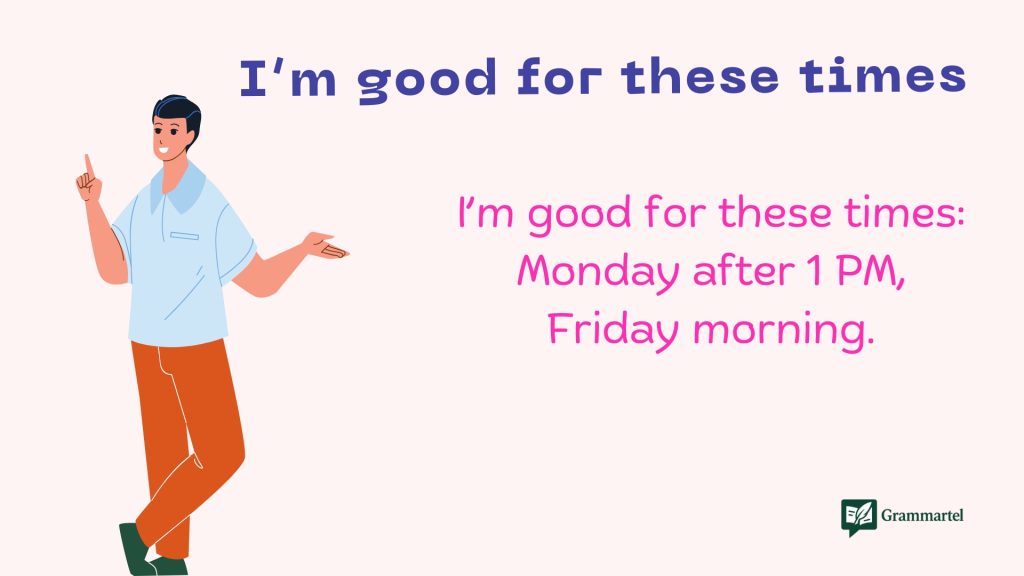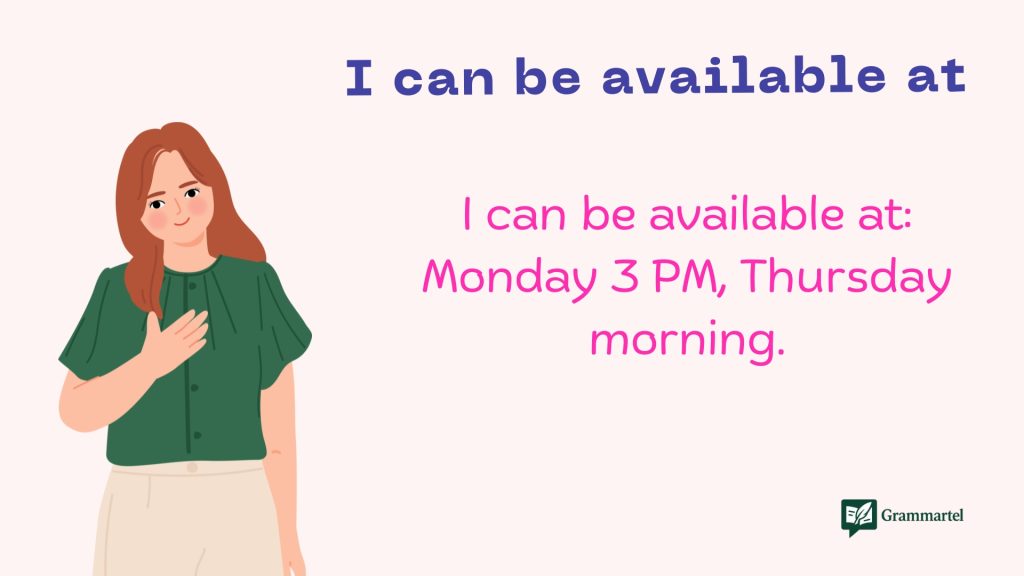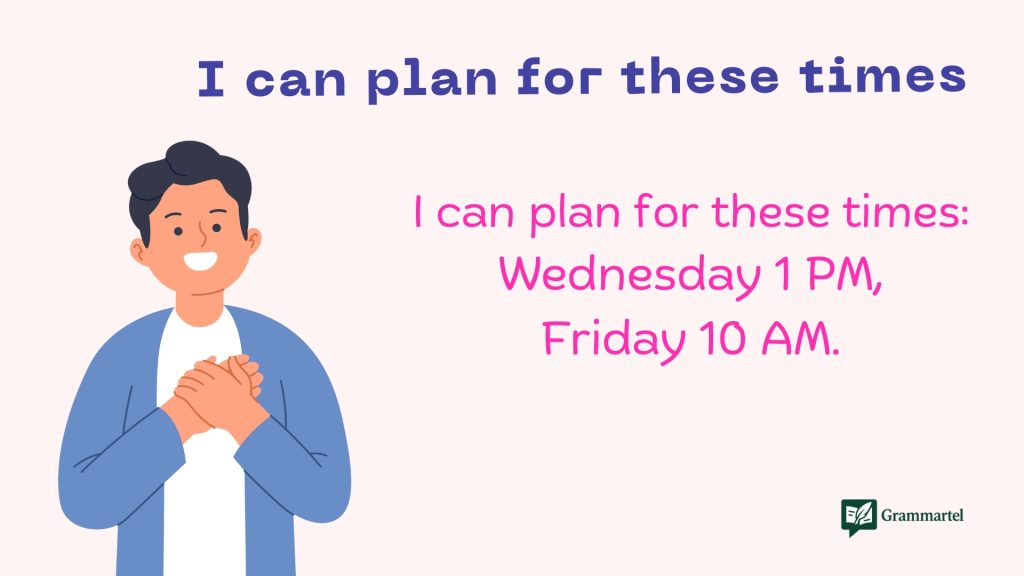When you’re setting up a meeting, interview, or even a coffee catch-up, how you share your schedule matters. Saying “My availability is as follows” works—but let’s be honest, it sounds a little stiff, right? Whether you’re writing an email, texting a colleague, or messaging a client, there are plenty of smoother, friendlier ways to say the same thing. From casual phrases to more professional options, we’ve rounded up 40 better alternatives that sound natural and fit different situations. So, if you’re tired of sounding robotic or overly formal, these fresh options will help you get your point across without the awkward tone.
What Does “My Availability Is as Follows” Mean?
The phrase “My availability is as follows” means you’re about to list the times or days you’re free. It’s a formal way to tell someone when you’re available to meet, call, or work. You’ll often see it in emails, especially for job interviews or appointments.
When to Use “My Availability Is as Follows”
Use it when you want to be clear and polite. For example, if a recruiter asks when you can talk, reply with:
“My availability is as follows: Monday to Wednesday, 2 PM to 5 PM.”
It keeps things simple and avoids confusion. You can also use this phrase in business settings or formal messages where tone matters.
40 Best Ways to Say “My Availability Is as Follows”
1. Here’s when I’m available

Meaning: States your open times directly.
Explanation: A casual, straightforward phrase suitable for quick emails or messages.
Example: Here’s when I’m available: Monday 3–5 PM, Thursday 10 AM–12 PM.
Best Use: Informal work chats, quick scheduling texts.
Worst Use: Formal proposals or business letters.
Tone: Friendly and casual.
2. I’m free at the following times
Meaning: Indicates your open schedule spots.
Explanation: Slightly informal but polite, it emphasizes your flexibility.
Example: I’m free at the following times: Wednesday after 2 PM, Friday morning.
Best Use: Coordinating with colleagues or clients you know well.
Worst Use: Highly formal corporate communication.
Tone: Warm and approachable.
3. My open slots are
Meaning: Lists specific times you can meet.
Explanation: Sounds efficient and time-focused, ideal for busy environments.
Example: My open slots are: Monday 1–3 PM, Thursday 9–11 AM.
Best Use: Internal team scheduling tools or quick Slack updates.
Worst Use: First-time introductions with formal clients.
Tone: Direct and efficient.
4. I can meet during the following windows
Meaning: Specifies periods you’re available.
Explanation: Slightly formal and well-suited for calendar coordination.
Example: I can meet during the following windows: Tuesday 10–12, Thursday 2–4.
Best Use: Emailing project stakeholders or professional contacts.
Worst Use: Very casual conversations.
Tone: Professional yet friendly.
5. These times work for me
Meaning: Shares your preferred times.
Explanation: Simple and positive, focusing on agreement rather than restriction.
Example: These times work for me: Wednesday 9 AM, Friday 1 PM.
Best Use: Negotiating meeting times in a collaborative tone.
Worst Use: Formal notices or contracts.
Tone: Cooperative and easygoing.
6. The times I’m free are
Meaning: Lists moments you’re available.
Explanation: Conversational and neutral, fitting for general use.
Example: The times I’m free are: Tuesday 11 AM–1 PM, Friday morning.
Best Use: Peer-to-peer communication, light business contexts.
Worst Use: Very formal reports or proposals.
Tone: Neutral and conversational.
7. I’m available at these times
Meaning: Shares exact availability in a direct way.
Explanation: Polite and concise, works across most settings.
Example: I’m available at these times: Monday 2–4 PM, Thursday 10 AM–12 PM.
Best Use: Standard business emails and scheduling tools.
Worst Use: Highly casual back-and-forths where formality isn’t needed.
Tone: Polite and clear.
8. I can do the following times
Meaning: Suggests times you can commit to.
Explanation: Slightly informal, but efficient for quick coordination.
Example: I can do the following times: Wednesday 8 AM, Friday after 2 PM.
Best Use: Internal team chats, scheduling with colleagues.
Worst Use: Formal legal or HR correspondence.
Tone: Light and practical.
9. Here are the slots I have free
Meaning: Indicates your available time slots.
Explanation: Has a friendly tone while still being clear.
Example: Here are the slots I have free: Tuesday 2–4, Thursday 9–11.
Best Use: Friendly client or coworker communications.
Worst Use: Formal RFP or business proposal.
Tone: Warm and personable.
Don’t miss : 40 Other Ways to Say “Nice to E-Meet You” (With Examples).
10. I’m open at the following times
Meaning: Lists periods when you’re open for meetings.
Explanation: Balances politeness with a hint of informality.
Example: I’m open at the following times: Monday 10 AM, Thursday after lunch.
Best Use: Semi-formal scheduling emails.
Worst Use: Strictly formal or ceremonial communication.
Tone: Relaxed but respectful.
11. Available times are
Meaning: Shares your time options without extra wording.
Explanation: Crisp and to the point, ideal for straightforward scheduling.
Example: Available times are: Tuesday 1–3 PM, Friday morning.
Best Use: Brief emails or meeting confirmations.
Worst Use: Conversational messages where warmth is expected.
Tone: Concise and neutral.
12. I can offer these times
Meaning: Suggests specific times you can provide.
Explanation: Slightly formal with a collaborative undertone.
Example: I can offer these times: Wednesday 9–11 AM, Thursday 3–5 PM.
Best Use: Professional but friendly correspondence.
Worst Use: Highly casual group chats.
Tone: Professional yet cooperative.
13. My calendar is open for
Meaning: Highlights times when your schedule allows meetings.
Explanation: Slightly polished, good for professional exchanges.
Example: My calendar is open for: Monday 2–4 PM, Thursday morning.
Best Use: Client scheduling emails.
Worst Use: Quick, informal messages.
Tone: Polished and courteous.
14. The times that suit me are
Meaning: Shows your availability while hinting at preference.
Explanation: Friendly yet gently assertive, suggesting mutual agreement.
Example: The times that suit me are: Tuesday 10 AM, Thursday 1 PM.
Best Use: Coordinating with colleagues or collaborators.
Worst Use: Strictly formal contracts or negotiations.
Tone: Cooperative and light.
15. I’m good for these times

Meaning: States when you’re fine to meet.
Explanation: Casual and reassuring, suitable for easygoing scheduling.
Example: I’m good for these times: Monday after 1 PM, Friday morning.
Best Use: Informal messages and chats.
Worst Use: Formal or ceremonial invites.
Tone: Friendly and relaxed.
16. Here’s my schedule availability
Meaning: Shares your open times in a structured way.
Explanation: Neutral and adaptable, works in many settings.
Example: Here’s my schedule availability: Wednesday 9–11, Thursday 2–4.
Best Use: Email replies, shared calendar notes.
Worst Use: Text messages or casual banter.
Tone: Neutral and straightforward.
17. I can make these times work
Meaning: Offers flexibility while listing your options.
Explanation: Sounds accommodating and solutions-oriented.
Example: I can make these times work: Tuesday 3 PM, Thursday 11 AM.
Best Use: Negotiating times with clients or coworkers.
Worst Use: Hardline business correspondence where flexibility isn’t relevant.
Tone: Flexible and positive.
18. My free periods are
Meaning: States specific open times in your day or week.
Explanation: Simple phrasing, often suited to internal schedules.
Example: My free periods are: Monday 10–12, Wednesday 1–3.
Best Use: Internal scheduling with colleagues.
Worst Use: Formal external communication.
Tone: Plain and informal.
19. The following times work
Meaning: Lists times that are acceptable for you.
Explanation: Clear and cooperative without extra flourish.
Example: The following times work: Tuesday 9 AM, Friday 2 PM.
Best Use: Professional but concise replies.
Worst Use: Overly casual chats.
Tone: Polite and matter-of-fact.
20. I’m good to meet at
Meaning: Indicates when you’re okay to meet.
Explanation: Informal but confident, suggesting readiness.
Example: I’m good to meet at: Monday 3 PM, Wednesday 10 AM.
Best Use: Quick email confirmations or team chats.
Worst Use: Formal event scheduling.
Tone: Casual and confident.
21. Here are my available slots
Meaning: Shares your free times clearly.
Explanation: A straightforward, easy-to-scan phrase.
Example: Here are my available slots: Tuesday 10–12, Thursday 1–3.
Best Use: Meeting invites or email scheduling.
Worst Use: Text messages to friends.
Tone: Professional and clear.
22. I can commit to these times
Meaning: Confirms your availability firmly.
Explanation: Works well when reliability is important.
Example: I can commit to these times: Monday 2–4 PM, Thursday morning.
Best Use: Formal or high-stakes scheduling.
Worst Use: Loose, casual coordination.
Tone: Serious and dependable.
23. My meeting availability is
Meaning: Shares your open meeting times.
Explanation: Works in corporate and formal contexts.
Example: My meeting availability is: Wednesday 9–11 AM, Friday after 2 PM.
Best Use: Business scheduling emails.
Worst Use: Non-work-related chats.
Tone: Professional and formal.
24. I can be available at

Meaning: States times you can make yourself free.
Explanation: Suggests willingness to adjust if needed.
Example: I can be available at: Monday 3 PM, Thursday morning.
Best Use: Negotiating with clients or peers.
Worst Use: Times when fixed schedules must be respected.
Tone: Cooperative and adaptable.
25. My availability looks like this
Meaning: Shares open times in a casual way.
Explanation: Conversational and friendly, works for approachable communication.
Example: My availability looks like this: Tuesday 11 AM, Thursday 2 PM.
Best Use: Team chats or friendly business emails.
Worst Use: Highly formal settings.
Tone: Warm and easygoing.
26. I can arrange for these times
Meaning: Indicates times you can plan to be available.
Explanation: Slightly formal with a flexible edge.
Example: I can arrange for these times: Wednesday 10 AM, Friday 3 PM.
Best Use: Professional coordination.
Worst Use: Very casual exchanges.
Tone: Polite and accommodating.
27. The windows I’m free are
Meaning: Lists specific time ranges.
Explanation: Useful when you have several blocks of time.
Example: The windows I’m free are: Monday 9–11, Thursday 2–4.
Best Use: Calendar sharing or meeting coordination.
Worst Use: Casual, non-time-sensitive talks.
Tone: Clear and structured.
28. I’m happy to meet at
Meaning: Shows availability while expressing willingness.
Explanation: Adds a touch of friendliness to scheduling.
Example: I’m happy to meet at: Tuesday 2 PM, Friday 10 AM.
Best Use: Client-friendly communication.
Worst Use: When tone needs to be strictly neutral.
Tone: Warm and welcoming.
29. Here’s what works for me
Meaning: Shares times that suit your schedule.
Explanation: A friendly, collaborative tone for coordination.
Example: Here’s what works for me: Monday 3 PM, Thursday 1 PM.
Best Use: Friendly client or coworker scheduling.
Worst Use: Strictly formal interactions.
Tone: Collaborative and personable.
30. I can confirm these times
Meaning: Lists times you’ve verified as open.
Explanation: Suggests reliability and readiness.
Example: I can confirm these times: Wednesday 11 AM, Friday 2 PM.
Best Use: Closing scheduling discussions.
Worst Use: Early-stage availability talks.
Tone: Assured and professional.
31. The slots I can do are
Meaning: Indicates times you can accommodate.
Explanation: Simple and adaptable for many situations.
Example: The slots I can do are: Tuesday 1–3 PM, Thursday 9–11 AM.
Best Use: Mid-level formal communication.
Worst Use: Very formal contracts.
Tone: Neutral and approachable.
32. I’m set for these times
Meaning: Confirms readiness for listed times.
Explanation: Slightly informal, showing you’re prepared.
Example: I’m set for these times: Monday 4 PM, Friday morning.
Best Use: Friendly team coordination.
Worst Use: High-stakes formal settings.
Tone: Casual and confident.
33. These are my open times
Meaning: Shares your available times plainly.
Explanation: Works across casual and semi-formal contexts.
Example: These are my open times: Tuesday 10–12, Thursday 1–3.
Best Use: Emails, chats, or shared calendars.
Worst Use: Strictly ceremonial messages.
Tone: Neutral and adaptable.
Check this out : 40 Best Ways to Say “Sweet Dreams” (With Examples).
34. I can fit you in at
Meaning: Suggests you can make time for someone.
Explanation: Implies flexibility and prioritization.
Example: I can fit you in at: Wednesday 2 PM, Friday 11 AM.
Best Use: Client relations and friendly professional communication.
Worst Use: Situations where equality in scheduling is key.
Tone: Accommodating and friendly.
35. My available windows are
Meaning: Lists your free time blocks.
Explanation: Slightly formal, best for clear scheduling.
Example: My available windows are: Monday 9–11, Thursday 3–5.
Best Use: Professional coordination.
Worst Use: Informal texts.
Tone: Professional and clear.
36. The times that work on my end are
Meaning: Shows your available times while focusing on mutual agreement.
Explanation: Collaborative phrasing that invites response.
Example: The times that work on my end are: Tuesday 2 PM, Thursday 10 AM.
Best Use: Negotiating with collaborators.
Worst Use: One-sided scheduling.
Tone: Cooperative and inclusive.
37. I’m okay with these times
Meaning: Lists times you find acceptable.
Explanation: Casual and flexible, but not overly enthusiastic.
Example: I’m okay with these times: Monday after lunch, Wednesday morning.
Best Use: Low-stakes internal scheduling.
Worst Use: Formal or client-facing events.
Tone: Easygoing and informal.
38. I can plan for these times

Meaning: Suggests you can arrange your schedule to fit.
Explanation: Shows willingness and dependability.
Example: I can plan for these times: Wednesday 1 PM, Friday 10 AM.
Best Use: Early-stage scheduling talks.
Worst Use: Immediate, urgent scheduling needs.
Tone: Cooperative and thoughtful.
39. My schedule allows for
Meaning: Lists times your schedule can accommodate.
Explanation: Slightly formal, useful in professional contexts.
Example: My schedule allows for: Tuesday 9–11, Thursday 2–4.
Best Use: Business scheduling emails.
Worst Use: Casual chats with friends.
Tone: Formal and clear.
40. I can free up time at
Meaning: Indicates you can make time for someone.
Explanation: Suggests accommodation and flexibility.
Example: I can free up time at: Monday 10 AM, Friday afternoon.
Best Use: Client and colleague coordination.
Worst Use: When times are non-negotiable.
Tone: Friendly and adaptable.
Conclusion
So, the next time you need to let someone know when you’re free, skip the usual line and pick a phrase that feels more like you. Whether it’s casual, polite, or straight to the point, the right wording can make your message clearer and friendlier. Communication doesn’t have to be stiff—sometimes, a small change in phrasing makes a big difference in how it lands.
Where strategy meets execution— Grammartel delivers measurable growth.

